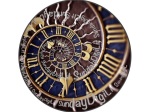In a world driven by technology, information is prized but this is not the end game.
Late 1990s:
At that time, when school reform models were being examined, my elementary school's magnet microsociety program was built on the Accelerated Schools model to "accelerate all students to high levels of achievement". All students were offered authentic, "real-world" learning experiences based on the content area of study. They were expected to notice, wonder, question, examine, analyze, make decisions, and work with teammates in a creative setting so that new knowledge would be constructed and exhibited. Constructivist theory was evident.
Examples:
Since the school was trying to provide authentic learning experiences, teachers and magnet coordinators met regularly to develop the program. At the 2nd grade level, one classroom of young scientists watched bird feeding patterns as part of their environmental studies and community living literacy program. Teams of students logged in daily observations in their journals, created charts with their findings, and presented short reports. 4th grade young historians delved into daily life in NYS and constructed authentic vignettes throughout the school with information and artifacts gathered. They also took on different roles as developers of a living museum. This was part of their combined literacy/social studies program.
Late 1990s:
At that time, when school reform models were being examined, my elementary school's magnet microsociety program was built on the Accelerated Schools model to "accelerate all students to high levels of achievement". All students were offered authentic, "real-world" learning experiences based on the content area of study. They were expected to notice, wonder, question, examine, analyze, make decisions, and work with teammates in a creative setting so that new knowledge would be constructed and exhibited. Constructivist theory was evident.
Examples:
Since the school was trying to provide authentic learning experiences, teachers and magnet coordinators met regularly to develop the program. At the 2nd grade level, one classroom of young scientists watched bird feeding patterns as part of their environmental studies and community living literacy program. Teams of students logged in daily observations in their journals, created charts with their findings, and presented short reports. 4th grade young historians delved into daily life in NYS and constructed authentic vignettes throughout the school with information and artifacts gathered. They also took on different roles as developers of a living museum. This was part of their combined literacy/social studies program.
21st Century Creative Models:
Fast forward to today. The growth mindset encourages educators to honor all learners and their different learning styles in student-centered classrooms where the collection of information is only part of the journey. The wonder of learning and the application of knowledge are valued during Genius hour, 20% time, and passion projects, contemporary versions of my early PBL learning experiences. Discussions, collaboration, explorations, and time to create are part of these authentic learning opportunities where choices are provided and agency developed. Classrooms like these are evident across the world.
Professional Development:
To support teachers interested in enriching, challenging programs for students, educational chats on Twitter and edcamps have sprouted up to discuss the whys and hows of student-centered authentic learning and innovation.
George Couros, an "innovative teaching, learning, and leadership consultant" and author of The Innovator's Mindset, has introduced the innovator's mindset for educators to ponder. The sketchnote below explains Couros' thinking.
Fast forward to today. The growth mindset encourages educators to honor all learners and their different learning styles in student-centered classrooms where the collection of information is only part of the journey. The wonder of learning and the application of knowledge are valued during Genius hour, 20% time, and passion projects, contemporary versions of my early PBL learning experiences. Discussions, collaboration, explorations, and time to create are part of these authentic learning opportunities where choices are provided and agency developed. Classrooms like these are evident across the world.
Professional Development:
To support teachers interested in enriching, challenging programs for students, educational chats on Twitter and edcamps have sprouted up to discuss the whys and hows of student-centered authentic learning and innovation.
George Couros, an "innovative teaching, learning, and leadership consultant" and author of The Innovator's Mindset, has introduced the innovator's mindset for educators to ponder. The sketchnote below explains Couros' thinking.

Couros provides discussion questions that we can ask ourselves when developing new, relevant learning activities. One that I feel is important is: What is an example of a practice that you would consider to be innovative? How is it new or better than what you had before?
Reflection:
During the late 1990s, when the microsociety was created, the program was considered to be innovative for elementary students. We studied other schools that had similar models at the secondary level and visited one at the elementary level. We linked with the regional BOCES center and presented at workshops. This was before the innovator's mindset was developed. Success was based on the level of involvement of each classroom, as it always is.
Actionable Step To Take:
As dedicated educators, we need to constantly create better programs and student-centered learning experiences; provide teachers with support to become the guides on journeys toward wondrous learning; equip students with the tools to become life ready, lifelong learners. Is this doable? Absolutely, it just takes commitment, energy, and passion.




No comments:
Post a Comment